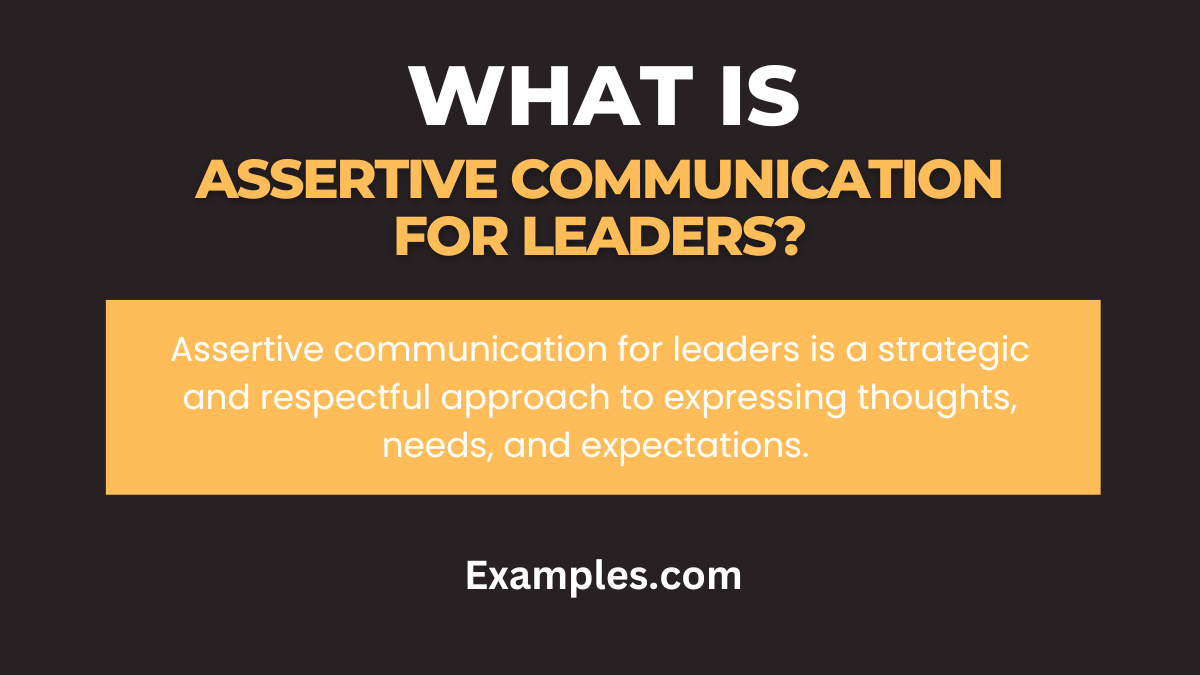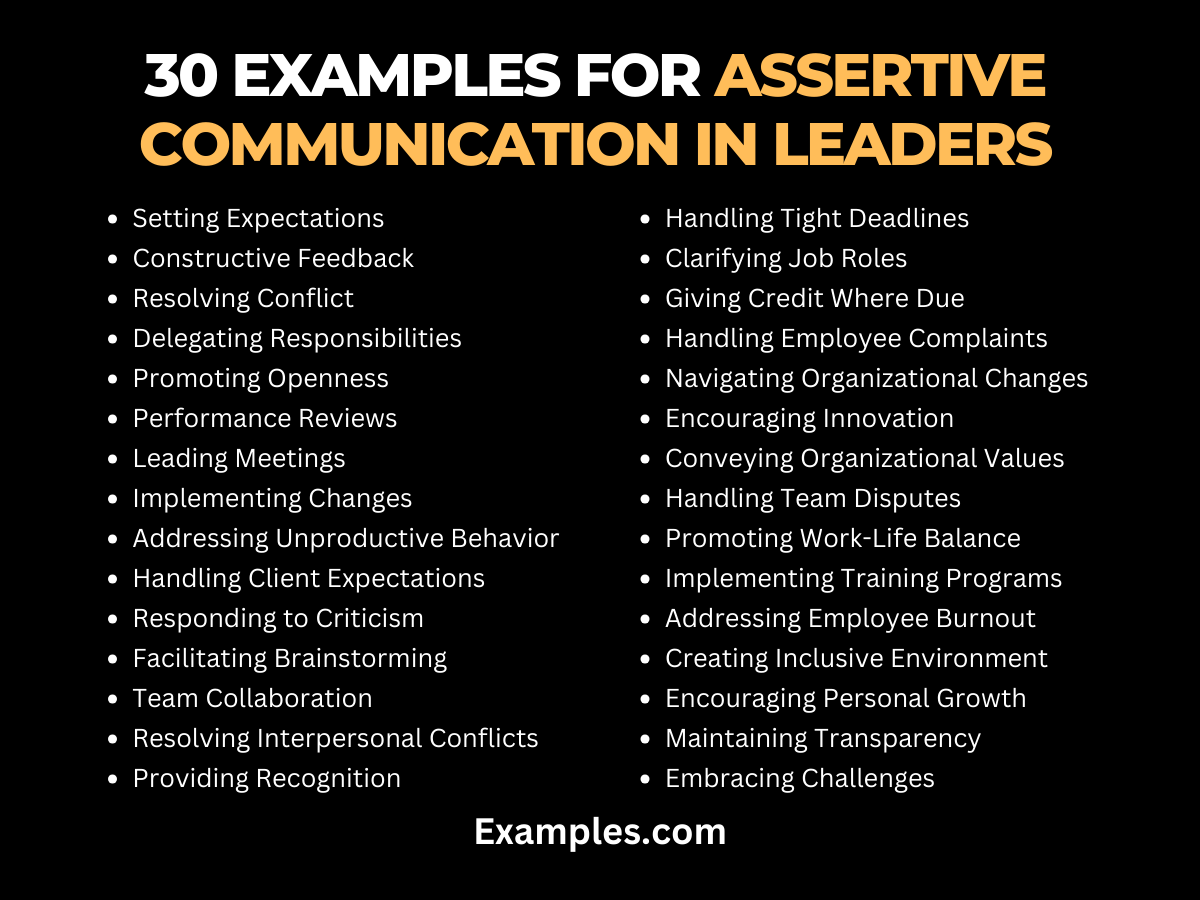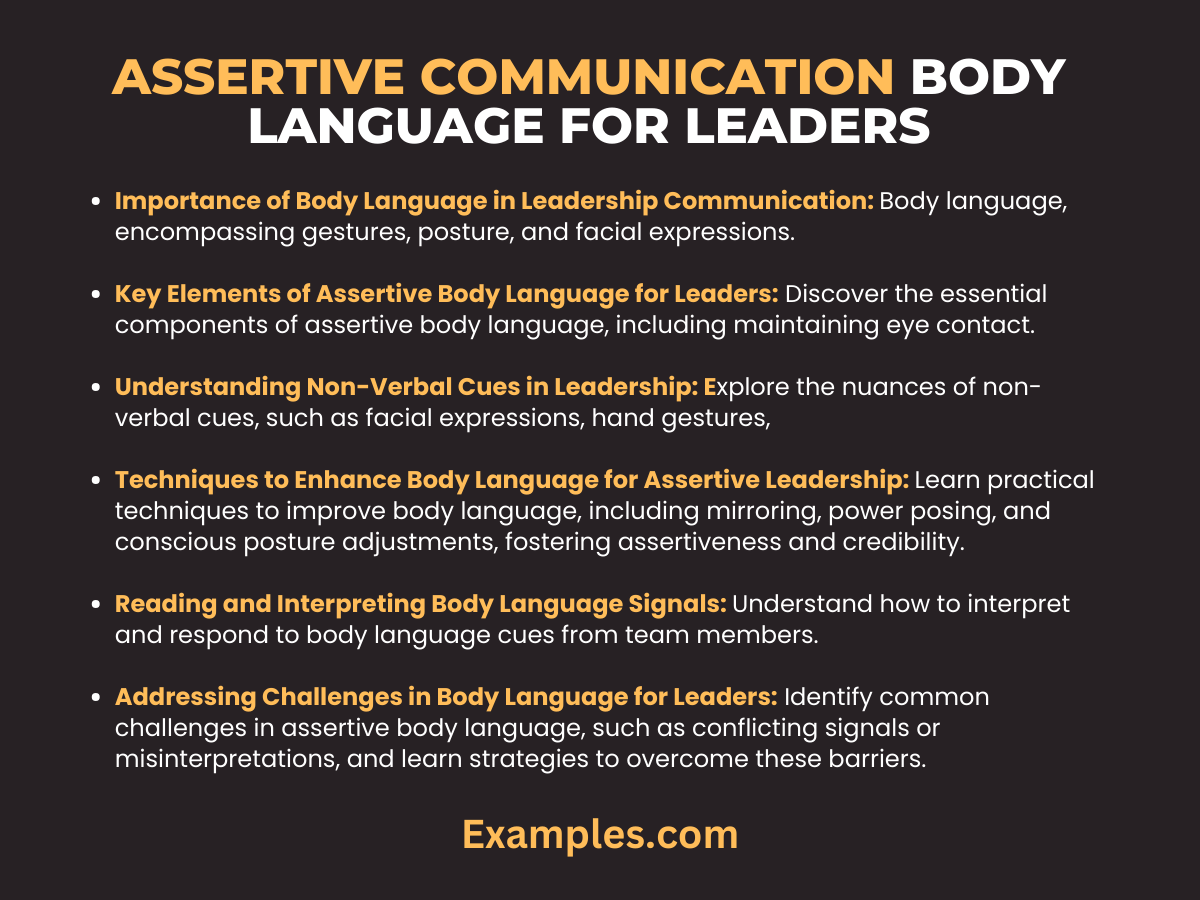Assertive Communication for Leaders
Empower your leadership journey with Assertive Communication for Leaders – a comprehensive guide to mastering this influential skill. Explore the definition, historical context, and origins of assertiveness, backed by real-world examples. Discover effective tips and practical insights on how to integrate assertive communication seamlessly into your leadership style. Elevate your leadership effectiveness with clear expression, respectful tone, and strategic confidence. Unleash the potential of assertiveness for impactful leadership in today’s dynamic landscape.
What is Assertive Communication for Leaders?

Assertive communication for leaders is a strategic and respectful approach to expressing thoughts, needs, and expectations. It involves conveying ideas with clarity, maintaining a confident tone, and respecting the perspectives of others. Leaders practicing assertive communication strike a balance between directness and empathy, fostering open dialogue, collaboration, and a positive work culture. This approach empowers leaders to navigate challenges effectively, build trust, and inspire cohesive and high-performing teams.
30 Examples for Assertive Communication in Leaders

Crafting assertive communication for leaders involves clear articulation, confident expression, and respectful interaction. Here’s a concise overview along with impactful examples:
- Setting Expectations: Clearly outline project goals and timelines, ensuring alignment and accountability within the team. How to communicate: Directly share project deadlines and expected outcomes.
- Constructive Feedback: Provide feedback that encourages growth, focusing on improvement rather than criticism. How to communicate: Address areas for development while highlighting strengths.
- Resolving Conflict: Mediate disagreements calmly, aiming for a mutually agreeable resolution. How to communicate: Facilitate a discussion to understand perspectives and find common ground.
- Delegating Responsibilities: Allocate tasks efficiently based on team members’ strengths and expertise. How to communicate: Assign duties while considering individual capabilities.
- Promoting Openness: Foster an environment where team members feel comfortable sharing ideas and opinions. How to communicate: Encourage participation in meetings and discussions.
- Performance Reviews: Conduct reviews transparently, acknowledging achievements and areas for growth. How to communicate: Provide detailed feedback on performance objectively.
- Leading Meetings: Guide discussions effectively, ensuring everyone’s contributions are valued. How to communicate: Facilitate discussions without dominating the conversation.
- Implementing Changes: Communicate alterations in processes clearly, emphasizing benefits and rationale. How to communicate: Explain the need for change and its positive impact.
- Addressing Unproductive Behavior: Discuss the impact of unproductive behavior on team dynamics while offering support. How to communicate: Explain the consequences of certain actions.
- Handling Client Expectations: Manage client expectations realistically, maintaining transparent communication. How to communicate: Clearly outline deliverables and potential limitations.
- Responding to Criticism: Respond to external critique professionally, considering feedback for improvement. How to communicate: Acknowledge feedback and express willingness to address concerns.
- Facilitating Brainstorming: Encourage brainstorming sessions that welcome diverse ideas and viewpoints. How to communicate: Prompt team members to share innovative thoughts openly.
- Team Collaboration: Foster a culture that emphasizes collective effort and mutual support. How to communicate: Highlight the importance of teamwork and collaboration.
- Resolving Interpersonal Conflicts: Mediate conflicts between team members to restore harmony. How to communicate: Encourage discussion to find common ground.
- Providing Recognition: Acknowledge individual achievements and contributions openly. How to communicate: Publicly appreciate outstanding performance.
- Handling Tight Deadlines: Communicate expectations during crunch times, prioritizing tasks effectively. How to communicate: Clearly outline urgent tasks and their importance.
- Clarifying Job Roles: Clearly define roles and responsibilities to prevent confusion. How to communicate: Outline duties and expectations explicitly.
- Giving Credit Where Due: Acknowledge the contributions of team members for collective success. How to communicate: Highlight individual efforts in a group accomplishment.
- Handling Employee Complaints: Address employee grievances promptly and with empathy. How to communicate: Listen attentively and offer solutions.
- Navigating Organizational Changes: Guide teams through transitions, ensuring seamless adaptation. How to communicate: Explain changes and their long-term benefits.
- Encouraging Innovation: Promote an environment that fosters creative thinking and innovation. How to communicate: Encourage unconventional ideas.
- Conveying Organizational Values: Clearly articulate the company’s values and mission for alignment. How to communicate: Emphasize the importance of shared values.
- Handling Team Disputes: Resolve disputes between team members impartially. How to communicate: Facilitate discussions to reach a resolution.
- Promoting Work-Life Balance: Advocate for a healthy work-life balance to enhance productivity. How to communicate: Highlight the importance of mental well-being.
- Implementing Training Programs: Communicate the necessity and benefits of training programs for skill enhancement. How to communicate: Explain the relevance of training for career growth.
- Addressing Employee Burnout: Recognize signs of burnout and take measures to support employee well-being. How to communicate: Offer resources and support.
- Creating Inclusive Environment: Ensure inclusion and diversity, fostering a welcoming workplace. How to communicate: Emphasize the importance of diverse perspectives.
- Encouraging Personal Growth: Support individual development and learning opportunities. How to communicate: Provide resources for skill enhancement.
- Maintaining Transparency: Share information openly, promoting trust within the team. How to communicate: Share updates and information regularly.
- Embracing Challenges: Encourage the team to view challenges as growth opportunities. How to communicate: Discuss the potential for learning and development through adversity.
Assertive Communication Body Language For Leaders

Body language plays a pivotal role in assertive communication for leaders. Here’s a comprehensive guide to mastering body language skills:
Importance of Body Language in Leadership Communication: Body language, encompassing gestures, posture, and facial expressions, profoundly impacts leadership communication. Explore its significance and influence in effective communication.
Key Elements of Assertive Body Language for Leaders: Discover the essential components of assertive body language, including maintaining eye contact, using open gestures, and controlling posture, vital for conveying confidence and authority.
Understanding Non-Verbal Cues in Leadership: Explore the nuances of non-verbal cues, such as facial expressions, hand gestures, and body posture, in conveying messages, building rapport, and enhancing leadership presence.
Techniques to Enhance Body Language for Assertive Leadership: Learn practical techniques to improve body language, including mirroring, power posing, and conscious posture adjustments, fostering assertiveness and credibility.
Reading and Interpreting Body Language Signals: Understand how to interpret and respond to body language cues from team members, enabling leaders to gauge engagement, understanding, and concerns effectively.
Addressing Challenges in Body Language for Leaders: Identify common challenges in assertive body language, such as conflicting signals or misinterpretations, and learn strategies to overcome these barriers.
Adapting Body Language to Different Leadership Scenarios: Explore how body language varies in diverse leadership scenarios, from team meetings to presentations, and how to adapt assertive body language accordingly.
Practicing and Implementing Assertive Body Language: Discover practical exercises and scenarios to practice assertive body language, fostering confidence, authenticity, and impactful leadership communication.
Assertive Communication Politics For Leaders
In the realm of leadership, navigating political landscapes requires a delicate balance of assertiveness, diplomacy, and strategic communication skills. Here’s an in-depth guide tailored for leaders to master assertive communication within the complex political arenas:
Understanding Political Dynamics: Political landscapes within organizations or external contexts often involve power dynamics, differing agendas, and conflicting interests. Understanding these dynamics is crucial for leaders to navigate assertively.
Building Alliances and Relationships: Leaders need to cultivate alliances and establish constructive relationships across diverse stakeholders. Assertive communication aids in creating alliances, ensuring mutual respect, and fostering collaboration even amidst varying interests.
Diplomatic Negotiations and Persuasion: Effective leaders employ assertive communication to negotiate persuasively, advocating their positions while considering others’ viewpoints. This skill enables the resolution of conflicts and the advancement of shared goals.
Strategic Communication Tactics: Strategically communicating plans, ideas, and objectives involves assertive yet diplomatic approaches. Leaders must tailor messages, adapting their communication style to diverse audiences while maintaining authenticity.
Handling Sensitive Issues and Controversies: Assertive communication helps leaders address sensitive or controversial topics with grace and clarity. It involves navigating complex discussions while preserving relationships and credibility.
Conflict Resolution and Mediation: Leaders adept in assertive communication manage conflicts by fostering open dialogues, seeking resolutions, and mediating disputes while upholding fairness and impartiality.
Effective leadership hinges on the mastery of assertive communication skills. Here’s a comprehensive guide on the fundamental components that empower leaders in fostering a positive and productive work environment.
What Are The Basic Components Of Assertive Communication Leaders?
1. Clarity in Expression: Clear communication is the cornerstone of assertiveness. Leaders must articulate thoughts, expectations, and instructions with precision. This clarity ensures that team members understand the message without ambiguity.
2. Honesty and Transparency: Leadership thrives on trust, and honesty is its currency. Leaders practicing assertive communication are transparent about information, challenges, and decisions. This transparency builds credibility and fosters a culture of openness.
3. Respectful Tone and Language: Assertive leaders prioritize respect in their communication. Tone and language play a pivotal role in conveying messages. Maintaining a respectful tone, even during disagreements, contributes to a healthy and collaborative work environment.
4. Confidence in Communication: Confidence inspires confidence. Assertive leaders exude assurance in their communication, instilling trust in their team. Confidence is not about arrogance but about conveying assurance in one’s decisions and directions.
5. Empathy in Understanding: Empathy is a potent tool in assertive communication. Leaders who empathize with their team members’ perspectives create a supportive atmosphere. Understanding others’ feelings and concerns fosters stronger relationships and collaboration.
The Importance Of Assertive Communication For Leaders
Effective leadership hinges on the mastery of assertive communication skills, a cornerstone in fostering a healthy, productive work environment. Assertiveness empowers leaders to express their thoughts, needs, and expectations clearly while respecting the perspectives of others. This guide explores the crucial role of assertive communication for leaders, emphasizing its impact on team dynamics, organizational culture, and overall success.
Building Stronger Connections: Assertive communication establishes trust and transparency among team members. Leaders who communicate assertively build stronger connections by fostering open, honest, and respectful interactions, creating a foundation for collaborative success.
Enhancing Decision-Making: Leadership often involves making critical decisions. Assertive communication ensures that leaders can express their decisions clearly and confidently, reducing the likelihood of misunderstandings or ambiguity. This clarity contributes to more effective decision implementation and organizational alignment.
Creating a Positive Work Culture: Leaders who model assertive communication contribute to a positive work culture. By encouraging team members to express their opinions and ideas without fear of reprisal, leaders foster an atmosphere of inclusivity, creativity, and continuous improvement.
Resolving Conflicts Effectively: Conflict is inevitable in any workplace, but assertive leaders can navigate these challenges adeptly. Assertive communication provides leaders with the tools to address conflicts promptly, objectively, and constructively, minimizing disruption and maintaining team morale.
Empowering Team Members: Assertive leaders empower their team members by encouraging them to voice concerns, share ideas, and contribute actively to discussions. This empowerment fosters a sense of ownership and commitment, enhancing overall team engagement and productivity.
Building Trust and Credibility: Leadership credibility rests on the ability to communicate assertively. Team members are more likely to trust leaders who express themselves clearly, consistently, and with integrity. This trust is foundational for effective leadership and team cohesion.
Why Assertive Communication Is Crucial For Leaders?
Effective leadership hinges on adept communication skills, with assertiveness playing a pivotal role. Here’s a comprehensive guide on why assertive communication is indispensable for leaders:
1. Fostering Team Alignment: Assertive communication ensures clarity in conveying expectations, goals, and directives. Leaders who articulate their vision assertively establish a shared understanding among team members, fostering alignment toward common objectives.
2. Building Trust and Credibility: Leaders who communicate assertively demonstrate confidence and transparency. This builds trust among team members, as they perceive their leader as someone who is clear, honest, and credible in their communication.
3. Enhancing Decision-Making: Assertive leaders express their opinions with confidence while remaining open to diverse perspectives. This approach facilitates robust decision-making, as it encourages the exploration of various viewpoints before arriving at well-informed choices.
4. Encouraging Open Dialogue: Assertive leaders create an environment where team members feel empowered to express their thoughts and ideas openly. This open dialogue fosters innovation, problem-solving, and a culture of continuous improvement within the team.
5. Conflict Resolution and Collaboration: In situations of conflict, assertive leaders address issues directly and constructively. They navigate disagreements with poise, seeking resolutions that satisfy all parties involved. This promotes a collaborative atmosphere and strengthens team dynamics.
In conclusion, assertive communication for leaders is not just a skill, but a crucial aspect of effective leadership. It enables leaders to express their thoughts, needs, and expectations in a manner that is both direct and respectful. This approach fosters a positive work culture, encourages open dialogue, and builds trust within teams. Leaders who master assertive communication are better equipped to navigate challenges, inspire their teams, and drive performance in today’s dynamic business landscape.
Moreover, assertive communication helps leaders in decision-making processes and conflict resolution, ensuring that their message is conveyed clearly and respectfully. By striking the right balance between assertiveness and empathy, leaders can create an environment of collaboration and mutual respect, which is essential for organizational success.
For further exploration on this topic, consider visiting the Harvard Business Review for their insights on leadership communication (Harvard Business Review) or explore the resources provided by the American Management Association for more practical guidance (American Management Association). These high-quality resources offer valuable information for leaders seeking to enhance their communication skills and leadership effectiveness.



